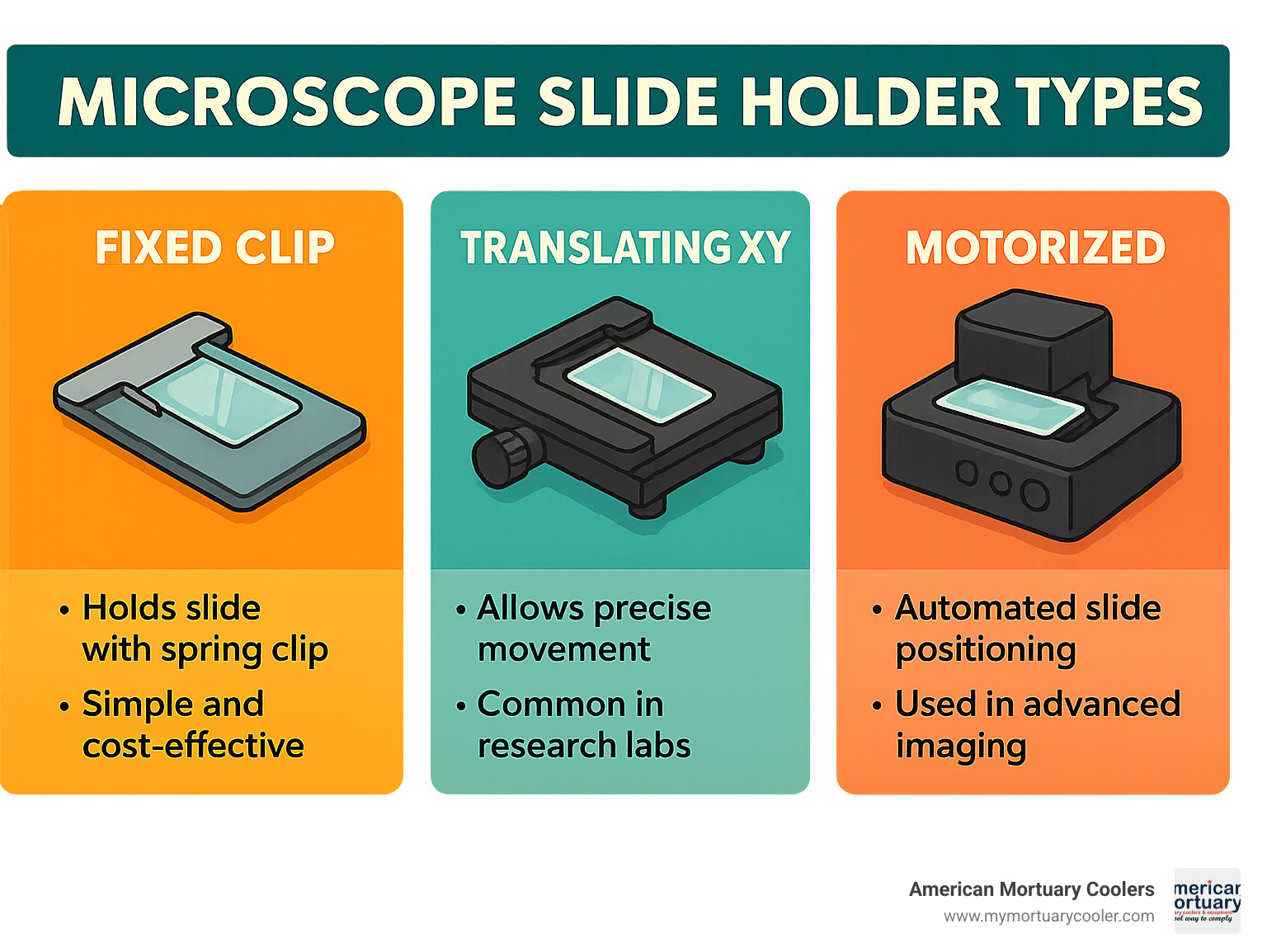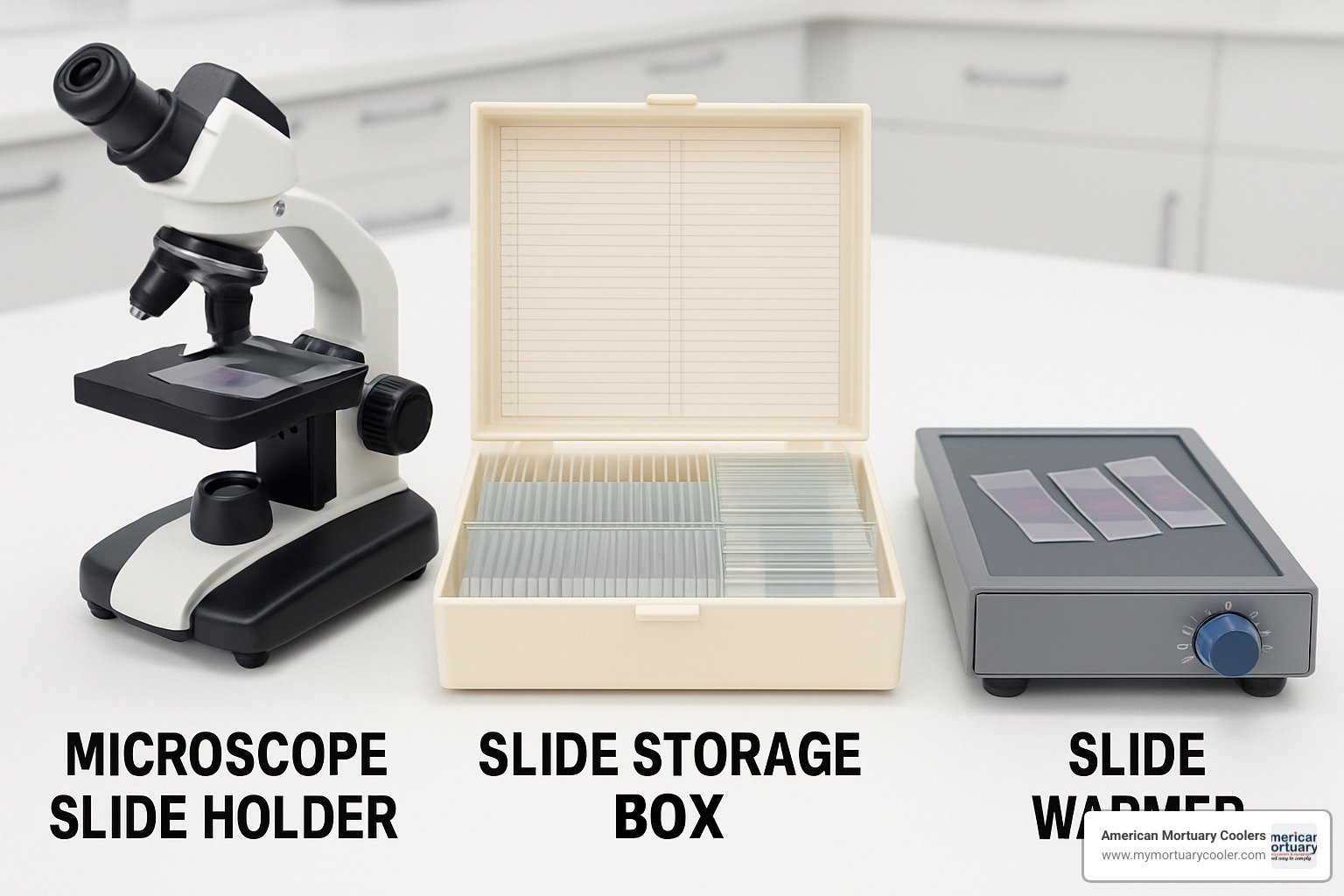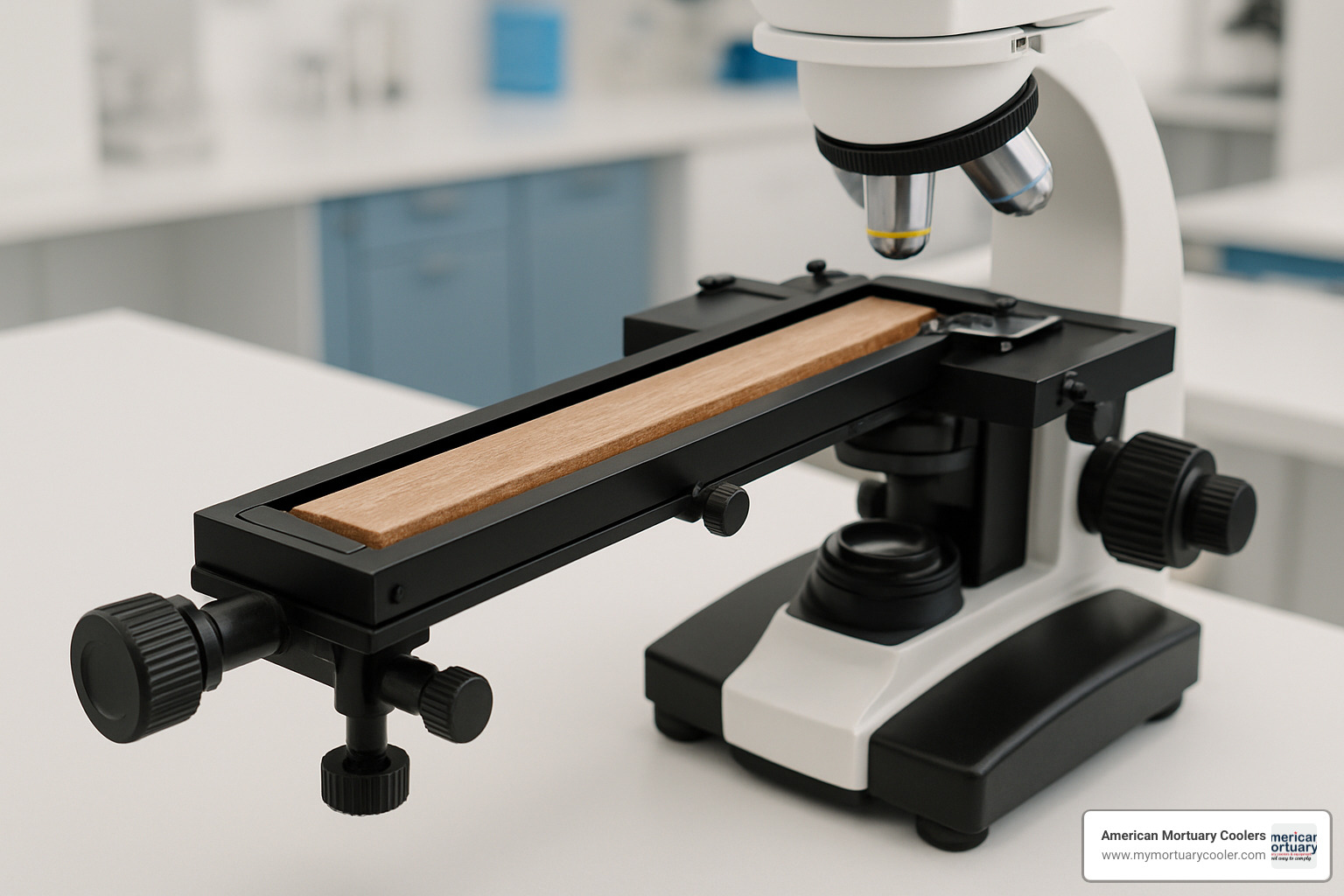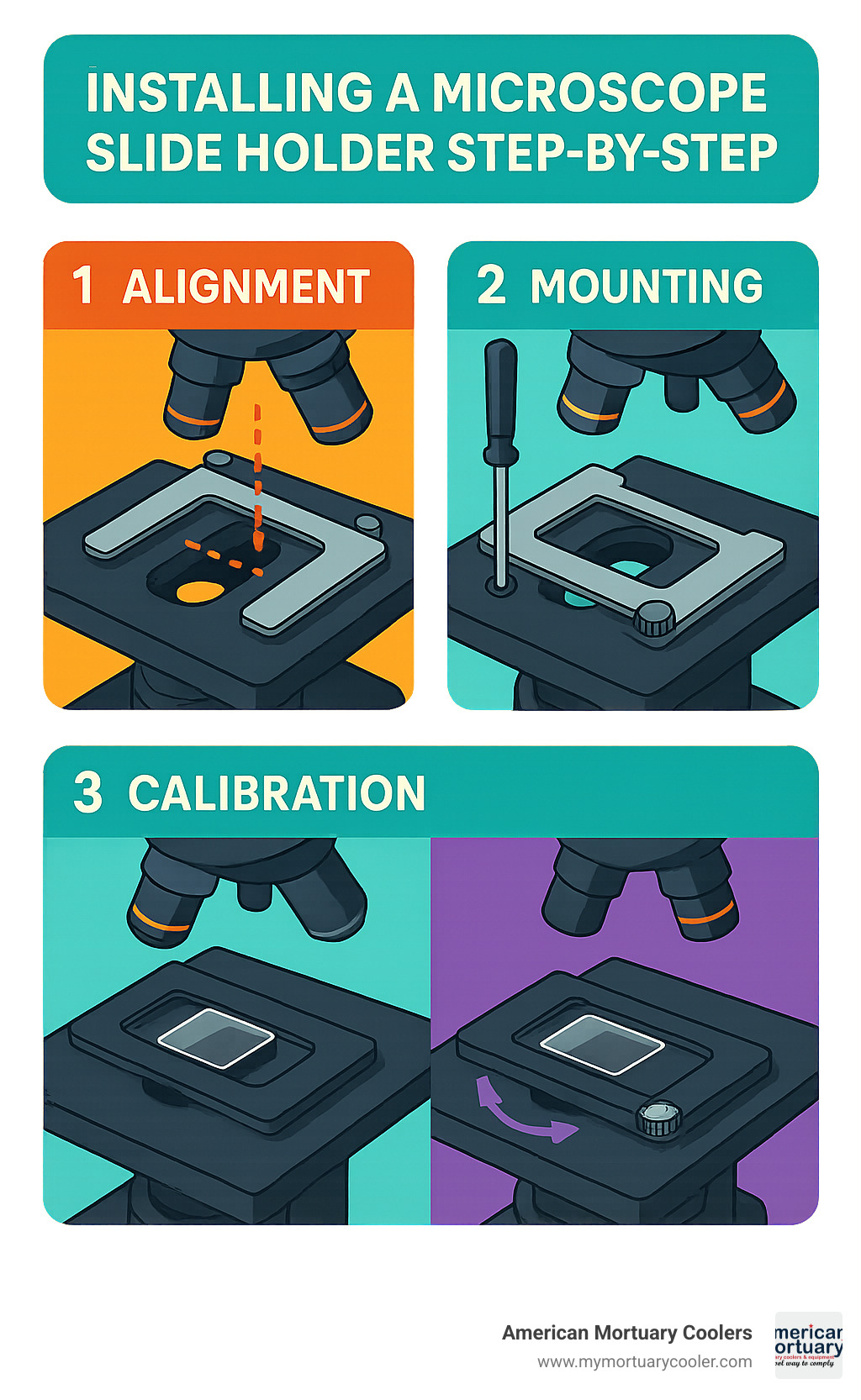
A Comprehensive Guide to Choosing the Right Microscope Slide Holder
The Critical Role of Microscope Slide Holders in Laboratory Precision
A microscope slide holder is a device designed to secure and position glass slides for optimal viewing under a microscope. For laboratory professionals seeking quick guidance:
| What It Is | Primary Function | Standard Size Compatibility |
|---|---|---|
| A mechanical device that attaches to the microscope stage | Secures microscope slides in place for stable viewing and precise positioning | Designed for standard 25 x 75 mm (1 x 3 inch) slides with thickness of 1.1 ± 0.2 mm |
Microscope slide holders serve as the crucial interface between specimens and the microscope's optical system. These precision instruments eliminate the frustration of slides shifting during critical observations and provide the stability needed for high-quality imaging. Whether examining tissue samples, cellular structures, or materials, the right slide holder can dramatically improve workflow efficiency and image quality.
The importance of a proper slide holder cannot be overstated—it's the foundation of reliable microscopy. From basic fixed holders with simple spring clips to sophisticated motorized systems offering precise XY positioning with 100 μm resolution, your choice directly impacts research outcomes and diagnostic accuracy.
Major microscope brands such as Thermo Fisher Scientific, Leica Biosystems, and Zeiss market their own slide-holder accessories, but laboratories often need solutions that integrate seamlessly with equipment from multiple providers—a flexibility American Mortuary Coolers prioritizes when sourcing holders for our clients.
I'm Mortuary Cooler, a national supplier of laboratory equipment with expertise in precision instruments including microscope slide holders that complement our broader storage solutions. My experience integrating slide management systems with laboratory workflows has shown that even small improvements in sample handling can significantly improve diagnostic precision and research productivity.

Handy microscope slide holder terms:
What Is a Microscope Slide Holder and Why Is It Essential?
A microscope slide holder is that mechanical device that keeps glass slides firmly in place on the microscope stage. It's the bridge between your specimens and the powerful optics of your microscope. Without this crucial tool, even the most expensive microscope would struggle to deliver clear, consistent results.
The beauty of a good microscope slide holder lies in its simplicity and effectiveness. It provides rock-solid positioning of samples while you're examining them through the lens.
Here's why these holders are essential in any laboratory setting:
First, they provide best sample stability. When working at high magnifications, even tiny movements can turn a crisp image into a blur. A quality microscope slide holder eliminates this frustration by keeping everything perfectly still.
Second, they allow for repeatable positioning. Need to show a colleague that fascinating cell structure you spotted yesterday? A good slide holder lets you mark and return to exact regions of interest with confidence.
Third, they dramatically improve imaging quality. The stability provided by a proper holder translates directly into sharper images with better resolution and contrast.
At American Mortuary Coolers, we appreciate that laboratory precision starts at the microscopic level. While our specialty lies in larger-scale cold storage solutions, we recognize that the same principles of reliability and precision apply equally to the smallest details of specimen management.
Microscope Slide Holder vs. Slide Storage Boxes & Warmers
It's easy to confuse microscope slide holders with their cousins – slide storage boxes and slide warmers. Let me clear up the differences, as each plays a distinct role in your laboratory workflow:
Your microscope slide holder is your active working tool – it's what you use during actual observation. With features like spring clips and XY translation capabilities, it's designed specifically for positioning and viewing specimens under the microscope.
Slide storage boxes are your organizational assistants. Available in various sizes holding anywhere from 25 to 100 slides and priced between $3.30 and $8.60 each, these compartmentalized boxes keep your slides safe, organized, and protected when not in use.
Slide warmers serve yet another distinct purpose. These flat heating surfaces maintain optimal temperatures (typically between 35-45°C) for specimen preparation, particularly in histology and pathology labs where proper mounting and drying of paraffin sections is critical.

Main Types of Microscope Slide Holders and Their Mechanisms
The market offers various designs that cater to different research needs, microscope types, and specimen characteristics. Let's explore these options to help you find the perfect match for your laboratory work.
Fixed & Spring-Clip Microscope Slide Holder Options
The most straightforward and budget-friendly options are fixed slide holders. These workhorses feature simple spring arm mechanisms that securely hold your slides in place. Typically crafted from durable stainless steel, they resist chemicals commonly used in laboratory settings while allowing for quick specimen exchanges—perfect for busy educational labs.
The MAX3SLH fixed slide holder is a no-nonsense solution for standard microscopy. For comparing samples or teaching, the C4SH01 four-position holder allows mounting multiple standard slides at once.
Spring clip holders add flexibility by rotating a full 360°, making it easy to access slides from any angle. They fit onto any microscope stage with 8-32 (M4) tapped holes, and their simple dowel pin alignment systems ensure consistent positioning.
These fixed holders excel in educational settings and routine clinical work where ease of use and affordability matter more than pinpoint positioning capabilities.
Translating & Motorized Microscope Slide Holder Benefits
When precision becomes paramount, translating and motorized microscope slide holders step in. These sophisticated devices offer XY travel capabilities—typically 50-100 mm horizontally and 30 mm vertically—with vernier scale positioning that can achieve resolution as fine as 100 μm. Their precision lead screws ensure smooth, controlled movements across specimens.
The XYF series of translation mounts exemplifies what's possible in this category. These holders let researchers systematically scan specimens with repeatable precision. For even greater control, motorized systems automate movement patterns.
Imagine programming specific scanning patterns for whole-slide imaging, operating your microscope remotely, or integrating with digital imaging systems for automated capture. These aren't just conveniences—they're game-changers for research quality.
For ultimate precision, piezo-driven Z-axis control systems like the LPS710E Amplified Piezo Stage offer up to 1100 μm of travel and resolution as fine as 2 nm, enabling incredibly precise focusing for advanced microscopy techniques.
Specialized Holders: Long Slides, Petri/Slide Combos, Inverted Stages
Beyond standard configurations, specialized microscope slide holders address unique research challenges across different scientific disciplines.
Long slide adapters accommodate slides up to 400 mm in length—essential for researchers working with wood-core samples in dendrochronology or examining geological specimens. These adapters often include both manual and mechanical shifting systems for precise positioning.

If your work involves both slides and cell cultures, combination holders like the MLS203P2 support both standard slides and culture dishes on inverted microscopes. Digital pathology has specialized needs met by slide scanner holders such as those in the PathScan Enabler 5, which can secure multiple slides for high-throughput digitization.
Key Specifications: Size, Materials, and Compatibility
Shopping for a microscope slide holder feels a bit like buying shoes for your microscope—get the wrong size, and nothing works quite right. Let's walk through what you need to know to find that perfect fit.
Standard Dimensions and Tolerances
Most labs around the world have standardized on a common slide size, which means microscope slide holders follow suit:
- Standard slide dimensions: 25 × 75 mm (1 × 3 inches)—the universal "business card" of the microscopy world
- Typical slide thickness: 1.1 ± 0.2 mm—thin enough for light to pass through but sturdy enough to handle
- Observation window dimensions: Usually between 20-40 mm, depending on the model
These measurements have evolved over decades to create a global standard that works across different manufacturers, microscopes, and applications.
Materials and Their Properties
The material of your microscope slide holder matters more than you might think:
| Material | Advantages | Limitations | Best For |
|---|---|---|---|
| Aluminum | Lightweight, corrosion-resistant when anodized, good thermal conductivity | Less durable than stainless steel | General laboratory use, educational settings |
| Stainless Steel | Excellent durability, superior chemical resistance, non-magnetic options available | Heavier, more expensive | Clinical environments, applications involving harsh chemicals |
| Engineering Polymers | Lightweight, chemical resistant, electrical insulation, low cost | Lower precision, less durability | Educational use, disposable applications |
At American Mortuary Coolers, we're passionate about materials. Just as we choose high-grade stainless steel for our mortuary coolers, quality microscope slide holders need materials that match their purpose.
Compatibility Considerations
Matching your microscope slide holder to your microscope is crucial. Here's what to check:
First, look at the mounting thread patterns. Most microscope stages use 8-32 (M4) tapped holes, but it's always worth double-checking before purchase.
Next, consider stage aperture alignment—your holder needs to center slides precisely over the light path.
For high-power work, working distance requirements become crucial. Some bulky holders can interfere with objective lenses at high magnifications.
And if you're using a motorized system, verify software integration compatibility.

Choosing the Best Microscope Slide Holder for Your Workflow
Finding your perfect microscope slide holder comes down to understanding your daily needs:
For Research Applications, consider translating or motorized holders that let you position specimens with micrometer accuracy. For repeatable results, vernier scales or digital position readouts are invaluable.
For Clinical Settings, durability and efficiency rule the day. Look for designs that make slide swapping quick and intuitive, and materials that withstand repeated cleaning with laboratory disinfectants.
For Teaching Environments, choose economical fixed holders with straightforward spring mechanisms that can survive occasional mishandling.
Budget considerations span from basic fixed holders starting around $30 to sophisticated motorized systems exceeding $600.
Installation, Maintenance, and Troubleshooting
Even the best microscope slide holder won't perform properly if it's not installed correctly or maintained regularly. A little preventive care goes a long way!
Installing a Microscope Slide Holder Step-by-Step
Installing your microscope slide holder doesn't have to be complicated:
First, prepare your microscope stage by cleaning it with isopropyl alcohol. Remove any existing holders or adapters. Locate the mounting holes or attachment points on your stage.
Next, position your new holder carefully. Alignment is key! Make sure the observation window sits directly over the light path, and check that you'll have proper clearance with the objective turret.
When securing the holder, use the appropriate mounting screws (typically 8-32 or M4) and tighten them evenly. For spring clip holders, use the provided dowel pins for proper alignment.
Before finishing, verify everything works properly. Test slide insertion and removal, check that spring mechanisms move smoothly, and for translating holders, confirm you have full range of motion in all directions.

Maintenance Best Practices
At American Mortuary Coolers, we know that regular maintenance isn't just about fixing problems—it's about preventing them.
Daily care: Remove slides after use and wipe down with a lint-free cloth to remove dust and debris. Check spring clips for consistent tension.
Weekly maintenance: Give your holder a more thorough cleaning with isopropanol, looking for signs of corrosion or wear. Pay special attention to moving parts—they should operate smoothly.
Monthly: Apply a tiny amount of lubrication to lead screws if recommended by the manufacturer. Check and tighten any loose mounting screws, and verify position indicators are calibrated correctly.
Annual maintenance: Conduct a comprehensive inspection of all components, replace worn springs or clips, and recalibrate vernier scales or digital indicators.
Common Issues & How to Fix Them
Even with perfect maintenance, problems can still occur. Here's how to tackle common microscope slide holder issues:
When slides drift during observation, check spring tension or worn clips. Try adjusting the tension first, but if clips are worn, replacement parts are usually inexpensive.
Stiff or uneven movement in translating holders typically indicates lead screws or rails need cleaning. A thorough cleaning with manufacturer-recommended solvent followed by fresh lubricant usually solves the problem.
For misalignment with the light path, loosen mounting screws, realign the holder carefully, and retighten everything evenly.
Vernier scale misreadings are often just a matter of technique. Review proper vernier reading procedures and ensure zero markers are correctly aligned.
If you experience slide warping or breakage, check for excessive pressure from spring clips or uneven mounting. Adjusting clip tension and ensuring even support can prevent damaged specimens.
Cost Overview and Accessory Add-Ons
When shopping for a microscope slide holder, prices vary dramatically depending on features needed for your specific work.
Price Ranges by Type
Basic fixed holders with simple spring mechanisms typically cost between $30-$150—perfect for educational settings and routine applications.
Translating holders with manual XY positioning capabilities generally fall in the $150-$350 range, offering precise positioning with vernier scales and typical travel ranges of about 50mm × 30mm.
Motorized systems start around $350 and climb above $600, providing automated positioning with software integration for labs requiring ultimate repeatability and precision.
Specialized holders come with specialized price tags. Long slide adapters might cost $200-$400, while combination holders for both slides and petri dishes typically range from $400-$600. High-end piezo-driven Z-axis systems can exceed $800.
Valuable Accessories and Add-ons
Your microscope slide holder is just the beginning. Consider these valuable accessories:
Replacement spring clips ($15-$30) are worth keeping on hand, as they're the components most likely to wear out. Some offer 360° rotation for more flexible access to specimens.
Adapters ($50-$150) can bridge the gap between different mounting standards or add translation capabilities to fixed mounts—particularly valuable for non-standard slide sizes.
Inventory cards ($5-$20) help track slide information and history, while color-coding options improve workflow efficiency, especially in busy multi-user labs.
Your slides need proper storage when not under the microscope. Slide racks and cabinets ($17-$159) come in various capacities from 25 to 100+ slides and complement your microscope slide holder by providing safe storage.
For histology applications, slide warmers ($200-$400) maintain optimal specimen temperature with digital temperature control for precise conditions.
At American Mortuary Coolers, we understand the value of investing in quality equipment. Just like our mortuary cooling systems, a well-chosen microscope slide holder and accessories represent an investment in laboratory precision that pays dividends through years of reliable service.
Frequently Asked Questions about Microscope Slide Holders
How do I know if a holder fits my microscope stage?
Matching your microscope slide holder to your microscope stage requires checking a few specific points:
First, examine the mounting hole pattern on your stage. Most microscopes use standard 8-32 or M4 tapped holes. Measure the distance between these mounting holes and compare with the holder specifications.
Check the alignment between your stage's light path and the holder's observation window. A misaligned holder won't position your slides correctly for viewing.
Consider clearance issues, especially with inverted microscopes or high-power objectives. You need adequate space between the holder and objective turret to prevent collisions.
If uncertain, contact your microscope manufacturer with your stage model information. Many microscope slide holder manufacturers offer compatibility charts for specific setups.
Are motorized slide holders worth the investment for small labs?
For small labs considering motorized microscope slide holders ($350-$600+), the value depends on your specific needs.
Motorized holders excel when your work involves systematic scanning across specimens. They save time and reduce hand fatigue from manual adjustments. For capturing multiple images or requiring precise, repeatable positioning, they become a smart investment rather than a luxury.
The precision improvement is significant—motorized systems offer dramatically better repeatability for detailed research or clinical applications.
However, be realistic about your requirements. If you only occasionally use your microscope for straightforward observations, the additional training, maintenance, and software compatibility considerations might outweigh the benefits. In these cases, a quality manual translating holder might be more practical.
What's the best way to label and track slides while using holders?
For effective slide labeling and tracking:
Use frosted-end slides that provide a writable surface without interfering with microscope slide holder mechanisms. Consider color-coded slide edges for quick visual sorting by specimen type. For permanent identification that withstands staining procedures, etched identifiers work best.
For documentation, simple inventory cards work well for smaller operations, while larger labs benefit from laboratory information systems that integrate slide tracking with other processes. Recording XY coordinates for regions of interest when using translating holders saves time when revisiting specific features.
Consistency is crucial—establish clear labeling conventions that everyone follows. Include essentials like date, specimen ID, stain type, and preparer's initials. Ensure labels don't obstruct the viewing area or interfere with how slides sit in the holder.
For critical specimens, implement a verification step before and after microscopy to prevent misidentified samples or lost data.
Conclusion
Finding the perfect microscope slide holder is an investment in your laboratory's success. Whether examining tissue samples or analyzing materials, the right holder forms the foundation of reliable microscopy work.
We've explored options from simple spring-clip holders for basic educational needs to sophisticated motorized systems that position specimens with incredible precision. Today's market offers solutions for every laboratory, regardless of specific requirements or budget constraints.
When selecting your microscope slide holder, consider:
- What your specimens need in terms of stability and positioning
- Whether your microscope's stage is compatible with your chosen holder
- How to balance budget against long-term quality benefits
- Which features will improve your daily workflow
At American Mortuary Coolers, we understand quality equipment from a unique perspective. While we specialize in larger-scale cold storage systems for the funeral industry, we recognize that precision engineering principles are universal—whether at macroscopic or microscopic levels. A well-designed microscope slide holder deserves the same attention to detail we put into our mortuary refrigeration solutions.
For our laboratory clients across Tennessee and nationwide, we recommend considering how microscope slide management connects to your broader laboratory storage strategy. There's a natural harmony between proper handling at the microscopic level and effective preservation at the macroscopic scale—both serving your commitment to accuracy and respect for specimens in your care.
By choosing quality equipment and maintaining it properly, you're creating a foundation for consistent, reliable results that will serve your laboratory for years. The right microscope slide holder is an unsung hero in the scientific process, quietly enabling findies that might otherwise remain out of reach.
For those interested in optimizing their broader laboratory storage solutions to complement their microscopy workflow, our team at American Mortuary Coolers is ready to help. Our specialists serve the Johnson City, TN area and deliver our custom solutions nationwide with the same commitment to quality that defines everything we do.
Learn how optimized cold storage complements slide management



